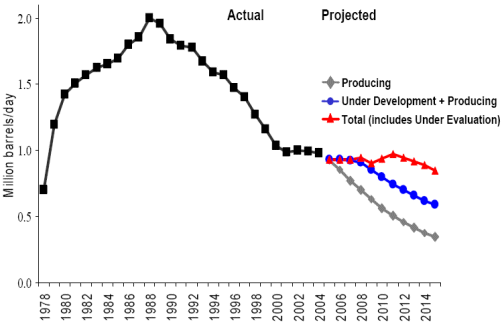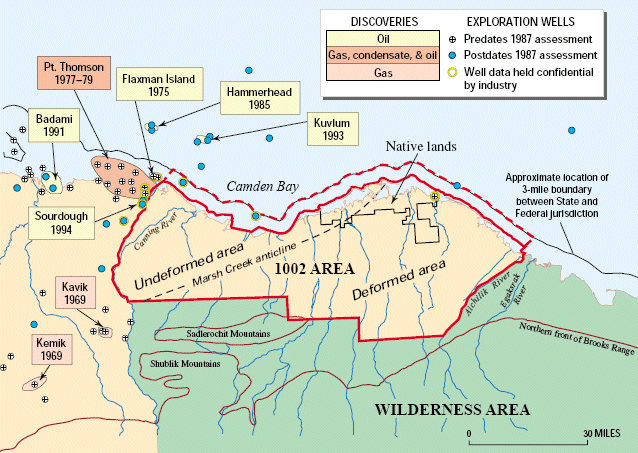Oil and Alaska; The ANWR Controversy
Introduction

The North Slope of Alaska and Canada hold a significant fraction of North America's remaining oil. Some areas, for example Prudhoe Bay, are already exploited. Other areas, for example the Arctic National Wildlife Refuge (ANWR), are largely untouched. After decades of controversy, it appears that 2005 will be the year that an energy bill will be passed permitting drilling in that area.
Planetforlife will attempt to shed light on this contentious subject. Both sides, it must be admitted, have overstated their cases. As much as possible, politics, opinions and science will be kept separate. The emphasis will be on facts and science. The information and the numbers provided here come largely from the Energy Information Agency (EIA) [1] and the United States Geological Survey (USGS). [2] The EIA is the "official source of energy statistics of the U.S. Government." [1] And the USGS says that it is an "unbiased science organization." These are government agencies and political influence can't be excluded. Politicians are short term thinkers by nature and they don't want voters to hear bad news. Therefore, if there is a bias, it is likely in the direction of optimism. In a democracy and in an open society, government agencies should be trustworthy.
History

USGS has provided this map of the northern Alaska.

That the coastal plain of northern Alaska is a good place to look for oil has been known for 100 years. There are oil seeps and oil stained rocks all over the area. President Harding set aside the National Petroleum Reserve-Alaska (NPRA) in 1923. Oil fields were found in NPRA but they were never big enough to make it worth the effort of drilling and transport.
That all changed when the area to the east of NPRA was explored. Discovered in 1968, the oil fields at Prudhoe Bay were the largest ever discovered in North America. At 25 billion barrels (in place), it ranked 18th in the world. In oil industry parlance, Prudhoe was an elephant. Oil wells were drilled and the 800 mile Trans Alaska Pipeline System (TAPS) was constructed. TAPS is jointly owned by several oil companies. TAPS was the largest privately funded project ever undertaken. The first oil reached the oil tanker port of Valdez in 1977. Since then, over 14 billion barrels of oil have been pumped from 19 producing North Slope fields. All North Slope oil must flow through TAPS because the Beaufort Sea is not navigable by oil tankers because it is often ice covered.
North Slope oil flowing through TAPS has been declining since 1988 as the following graph illustrates.
Oil delivered via the Trans Alaska Pipeline
(Source: Alaska Department of Revenue.[3])

The Alaska Department of Revenue has a strong interest in the amount of oil flowing through TAPS. It is a source of tax revenue sufficient to make other forms of revenue unnecessary. There is no state sales tax and no income tax in Alaska. There is a constitutionally protected account for TAPS revenues. It now holds 21 billion dollars while Alaska's total budget is only 2.5 billion. (Alaskans know that the oil will not last forever.) The principal of this account may not be spent (By law! It's in the Alaska constitution) but the income from this account pays for almost everything. There is enough left over to give every Alaskan about $2000 every year. [4]
It is interesting to know that the maximum delivery rate of TAPS is 2.14 million barrels per day. That rate is achieved by the use of "drag reduction agent injection." Note that TAPS ran flat out only in 1988. Without drag reduction, TAPS can deliver only 1.44 million barrels a day.
Prudhoe peaked in 1988 but now it is almost completely depleted. Most of the oil flowing through TAPS before 2000 came from Prudhoe. The leveling off of production observed after 2000 is the result of contributions from other North Slope areas.
Prudhoe originally held 25 billion barrels and 13 billion have been pumped from it. It would seem that Prudhoe could provide more oil. But the fact is, producing even 50 per cent of the oil is a major undertaking.
Managing an Oil Field

Every oil field is different. Sometimes the oil is viscous and tar like and sometimes the oil is a free flowing liquid. Sometimes the oil is in an actual pool and sometimes the oil is trapped in nearly impermeable rocks. Sometimes the oil is all connected and sometimes the oil is in isolated pockets. Some oil fields are located near a port navigable by oil tankers. (Kuwait would be an example.) Some oil fields must be accessed by long, mountain crossing pipelines. (Prudhoe would be an example.
All oil fields eventually stop producing. The amount that can be produced depends on all of these factors, plus others. The amount varies between 20% and 65%. The object is always to get as much oil as possible at minimum expense.
There are many ways to keep the oil flowing. Oil wells, especially in the Arctic, often produce natural gas. Some components of the natural gas are liquefied and added to the exported oil. But most of it is injected back into the well it came from. In fact, the natural gas makes numerous roundtrips. The injected natural gas helps maintain pressure and it reduces the viscosity of the oil. This natural gas can't be used for anything else because there is no economic way to transport it.
Sea water is also pumped into the oil field via special injection wells. But the oil that is flushed out in this way is a mixture of water and oil. This mixture must be separated. The percentage of water is called the "water cut." When the water cut gets too high, oil field becomes uneconomic.
Drilling more oil wells is also a way to keep the oil flowing. Advanced technology, such as horizontal drilling and the injection of steam and solvents also prolongs the life of an oil field.
It requires enormous capital and energy expenditures to keep the oil flowing. When the expenditures become too great, the oil field is abandoned. This is the fate of all oil fields. Prudhoe is near that point.
High oil price can justify greater capital expenditures but not greater energy expenditures. Oil is used to make energy and it makes no sense to expend energy to produce oil if it is not profitable in energy terms. The price of oil is only one factor in determining the point an oil field is abandoned.
Oil Field Terminology

How much oil is in an oil field? It seems like a simple question but the answer is complex. The United States Geological Service (USGS) provides this graph.

The USGS explains:
In-place resources. Volume of petroleum contained in accumulations of at least 50 MMBOE,
without regard to recoverability.
Technically recoverable resources. Volume of petroleum representing that proportion of assessed in-place resources
that may be recoverable using current recovery technology,
without regard to cost. (highlight
added)
Economically recoverable resources. Volume of technically recoverable petroleum for which the costs of discovery,
development, production, and transport, including a return to capital, can be recovered at a given market price.
95% probability level (F95). Refers to a 19 in 20 chance that the amount present will be at least as large as the amount shown.
5% probability level (F05). Refers to a 1 in 20 chance that the amount present will be at least as large as the amount shown.
The answer to a simple question can vary wildly. It depends on the exact question. Do you want to know how much oil is in the field? That would be the "in-place" oil. Do you want to know how much oil will actually be produced? That would be the "economically recoverable" oil. Do you want to know how much oil can be produced if you were unconstrained by cost and environmental considerations? That would be the "technically recoverable" oil. Do you want to know the very conservative estimate? That would be the "F95" estimate. Do you want the wildly optimistic estimate? That would be the "F05" estimate. There is also the "mean estimate." That is supposed to mean the estimate in the middle of the other estimates which implies enough estimates to be statistically meaningful.
ANWR Oil

This USGS provides this map.

A fraction of ANWR, known as the "1002 Area," is where the oil is. The 1002 area includes the native lands and an area extending 3 miles offshore. It is a simple question to ask how much oil is in ANWR. But the answer is complex.
The EIA says that ANWR has not been adequately explored or drilled making it impossible to make an adequate determination of either the amount or the quality of the oil.
40 USGS scientists spent 3 years preparing a 1998 report. Alaska agencies, federal agencies and several universities were involved. 1400 miles of seismic data collected by the petroleum industry were reanalyzed. Here are the USGS numbers for the entire 1002 area, including native lands and the offshore areas.
Technically recoverable oil:
F95 (pretty sure) 5.7 billion barrels,
F05 (outside chance) 16 billion barrels.
If native lands and the offshore areas are excluded:
Technically recoverable oil:
F95 (pretty sure) 4.3 billion barrels,
F05 (outside chance) 11.8 billion barrels.
ANWR oil is not another Prudhoe Bay. There is less oil and it is distributed in a large number of small fields dispersed over a large area. The oil is under the coastal plane and it tends to be concentrated in the "undeformed area."
Since "technically recoverable oil" means "recovery without regard to cost," it is not a good metric. The USGS should have provided numbers for economically recoverable oil. However, the USGS does provide this graph.

Presumably this graph would show technically recoverable oil if the vertical axis were extended to infinity. Planetforlife has added a small red dot near the top of this graph. It represents a guess for the mean case about how much oil ANWR will ultimately produce given that oil remains at $50. This includes native and offshore areas. Call it 7 billion barrels, about half of Prudhoe Bay. It might also be 3.5 or 11 billion.
Note that the curves are nearly vertical as they exit the top of graph. It means that large increases in the price of oil produce small increases in the amount of oil produced.
Here is a graph provided by EIA showing total Alaska oil exports.

The green represents all Alaska oil excluding ANWR. The green includes contributions from NPRA. Without ANWR total Alaska oil exports will fall below 500,000 barrels per day by 2025. 7 billion barrels from ANWR is enough to add 1 million barrels per day for 19 years. That would be the red and blue. There is 5% chance that ANWR will greatly exceed expectations as represented by the gray. The white represents all U.S. production outside of Alaska.
ANWR production will probably have the same history as Prudhoe Bay. It will peak in 2023, 10 years after production starts in 2013 and it will taper to zero in 2043.
ANWR has the potential to reduce oil imports by 5% for 2 decades beginning in 2015. Other sources of oil within the U.S. will be depleting during that time. There is no realistic way to reduce dependence on imported oil if oil consumption continues at its present rate.
TAPS, ANWR and NPRA

TAPS was very expensive to build. It is also very expensive to operate and maintain. [5]
TAPS has 11 pumping stations along its length. Each pumping station requires 30,000 to 60,000 gallons of turbine fuel each day. (It takes very powerful turbine powered pumps to make the oil go 800 miles over the mountains.) There is a network of roads to deliver the fuel, equipment and personnel to the pumping stations. The tanker terminal at Valdez has its own power plant which requires 40,000 gallons of fuel each day.
TAPS is vulnerable to corrosion, subsidence and even bullets. TAPS and the road network are subject to erosion, washouts, landslides and minor earthquakes.
Unforeseen events also must be counted as expenses. The Exxon Valdez disaster is an example everyone knows about. Less well known is an explosion that completely destroyed a pumping station. A major earthquake is possible and extensive damage to TAPS could result.
Economics determines a minimum flow rate for TAPS. It depends partly on the price of oil. The minimum flow rate is between 200,000 and 400,000 barrels per day.
The production of NPRA oil is not enough to keep TAPS running and even ANWR oil may not be sufficient. But together, there is probably enough oil production to keep TAPS running until about 2035.
This might be the strongest reason to exploit ANWR now.
Visualizing the Numbers

It is hard to relate to big numbers. All this about millions of barrels and billions of barrels is dizzying. The following might help you to relate.
The world consumes 80 million barrels of oil every day and U.S. (with 5% of the world's population) consumes 25% or 20 million barrels. The daily consumption of one U.S. citizen is 3 gallons or 21 pounds. U.S. citizens also consume energy in the form of natural gas, coal and lesser amounts of water power and nuclear power. In oil energy units, it amounts to about 63 pounds, or 10 gallons per person.
All of Earth's oil fields hold about 1148 billion barrels of economically recoverable oil. Most of the world's oil has already been discovered. OPEC countries have 77% and 68% is in the middle east and close to the Persian Gulf. [6] If production stays the same at 80 million barrels a day, the oil will last 40 years. (The EIA projects consumption to rise 2% per year.) Oil production must slow because it will be difficult and expensive to keep the oil flowing from depleted oil fields. Oil consumption will slow because oil will become expensive. The oil will not actually run out; it will become too expensive to be used much.
The 13 billion barrels produced by Prudhoe Bay fields is equal to 2 years of U.S. consumption. ANWR will provide less, even in the optimistic case.
The Trans Alaska Pipeline currently (2005) supplies 1 million barrels or 5% of the daily oil requirements of the U.S. Beginning in 2013, ANWR may supply a significant part of oil flowing through TAPS.
Environmental Considerations

A few points might be made:
The Arctic has very little ability to heal environmental damage because of the cold. The environment of ANWR will be almost permanently changed.
The greatest damage will be done during the last years of production when very intensive efforts are made to keep the oil flowing. These efforts will affect an area far greater than 2000 acres.
Regardless of your viewpoint or political persuasion, you must ask if the welfare of a few polar bears, caribou, seals and natives is worth it?
If you think in the long term, stewardship of the Earth is the most important objective. Earth is the only place humans live.
![]()
 [2]
http://www.usgs.gov/aboutusgs/
The United States Geological Survey website. The USGS has published a very nice Adobe
format article about ANWR which may be viewed here
.
You will need an Adobe viewer.
[2]
http://www.usgs.gov/aboutusgs/
The United States Geological Survey website. The USGS has published a very nice Adobe
format article about ANWR which may be viewed here
.
You will need an Adobe viewer.
[3] http://www.tax.state.ak.us/ The Alaska Department of Revenue website.
[4] http://governing.com/gpp/2003/gp3ak.htm Learn more about how the state of Alaska profits from oil.
[5] http://www.alyeska-pipe.com/Default.htm The Alyeska Pipeline website.
 [6] http://www.bp.com/ British Petroleum (BP) is a major oil company that publishes oil reserves data from the
Oil and Gas Journal in its annual Statistical Review of World Energy.
[6] http://www.bp.com/ British Petroleum (BP) is a major oil company that publishes oil reserves data from the
Oil and Gas Journal in its annual Statistical Review of World Energy.
